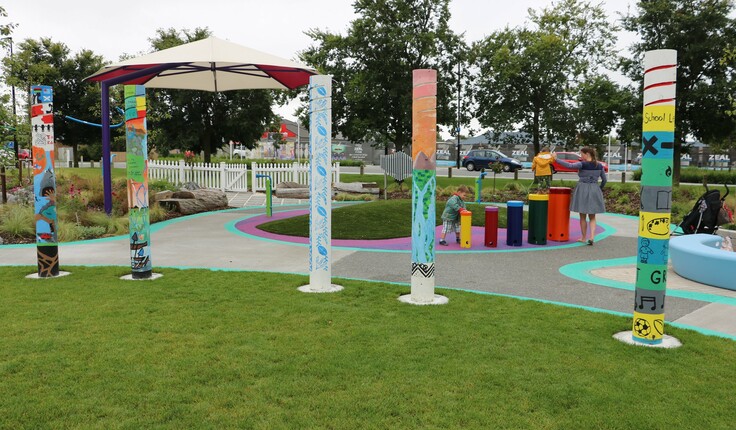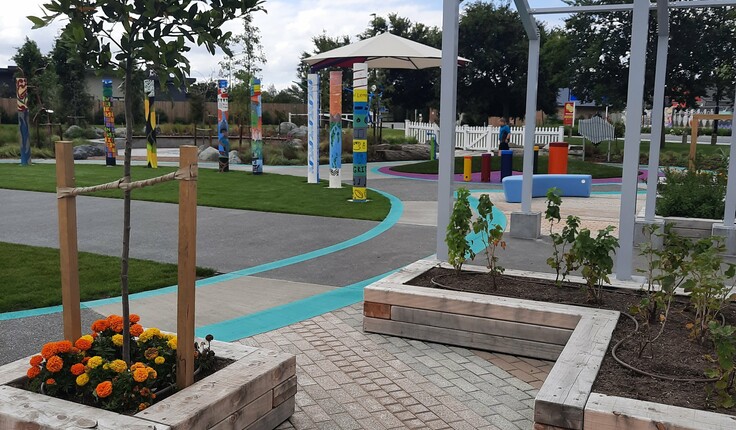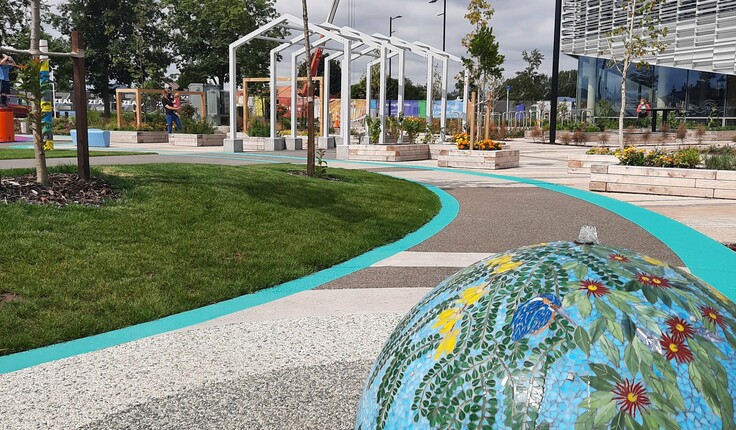News
A space to indulge your senses
Posted 22 02 2022
in News

While the sensory space in Rolleston town centre is enjoyed by the whole community it’s particularly special for the students of Waitaha School. Waitaha School is a school for students with special needs, whose pupils were important consultants in the design process.
“Some of the students don’t get to go to a town centre, into the hustle and bustle because they’re neurodiverse and they feel uncomfortable,” says Selwyn District Council landscape architect Dylan Robinson. “So we asked them what sort of environment would they thrive in, what did they need to be able to go there.
“They came up with a whole pile of ideas of what they would like to see and experience and we’ve taken them back to the drawing table and come up with a plan that includes a lot of those ideas.”
The result is a space that’s slightly offset from the (future) town centre - so it’s not right in the full noise - but allows those who are neurodiverse to be part of the community in a comfortable way. The head contractor was Armitage Williams Construction, with Morgan and Pollard Landscapes the lead landscape subcontractor.
Working with Rolleston Envirotown Community Garden, the council has planted a kai garden which will be used for workshops and education. There’s also raised beds of edible plants which provide touch, taste and smell experiences. An arbour frame, reminiscent of glasshouse frames, is nearby.
“I’ve been reading a bit around dementia and the prompting of feelings and memories, the idea being that as that space develops and becomes more productive you get the visual of the produce and being able to touch and taste,” says Robinson. “With the raised beds if you’re in a wheelchair you can still reach them, so all manner of people can be interacting with those areas.”
The main paths are designed as circles, a deliberate move inspired by Waitaha students. “It’s about understanding that some of their students like to keep moving and the circular motion is pretty good for them. They might do it non-stop for ages.” The edges of those circles are painted in Waitaha school colours to provide the students with a point of familiarity.


One of the circles concentrates on sound and touch, with bongo drums, a chime xylophone and a talk tube. In the middle is an astroturf mound, requested by Waitaha school because pupils love the feel of the astroturf and the way it gets hotter or cooler. An umbrella shades part of it so users can relax under it. “That’s a neat, simple space that’s not programmed as such but allows people just to be.”
The space furthest away from the future town centre is the quiet space, as far away as you can get from noise and movement. It’s a tactile space with a low concrete wall with different finishes. In the centre sits a mosaic artwork with different tiles hand painted by the students. A tree acts as shelter so visitors can just sit and look, feel different textures under their hands. The fragrance of sage, rosemary and star jasmine wafts around.
A Queensland Bottle tree - or “Dr Suess” tree as the project team likes to call it - takes centre stage in the tactile pathway. “Eventually in time it’ll form a really cool shape, a sculpture in it’s own right,” he says. Around that there’s a series of different surfaces including a timber boardwalk with bells in it; bricks and riverstones; and a water ball feature which is activated by pressure on a button in the ground.
A “whimsical, country-style” area is planted with perennials and some evergreens to provide a visual experience that differs according to the season. Maintenance teams have been instructed not to remove deadheads on flowers - making it the antithesis of perfectly manicured public spaces. “I really encourage biodiversity and ecological views on planting,” says Robinson. “Already we’ve seen loads of bees in the area.” It also means seeds can be collected to germinate more plants.
“I have had some feedback from friends that they’ve been quite inspired by the different style of garden in a public space. It’s quite neat to challenge the norm for a public space. I know it has its maintenance challenges but we’re working through them.
“A lot of what we (usually) do is using plants that we know because you know that they work and will function for a client. Whereas with this project I’ve had a chance to branch out a bit.”
Robinson says it’s been a truly rewarding, fun experience. “There’s nothing better in my view than producing a space for the community that you can then sit back and watch people enjoy.”
Share
12 Jan
Reminder: National Hui on RMA Reforms - Wellington, Tuesday 20 January

There is still time to confirm your attendance
Kia ora koutou, and welcome back to the new year. Before the break, the Environmental Legislation Working Group shared updates …
12 Jan
Reminder: log your CPD points

Certificates coming soon
A reminder to all Registered members - please log your CPD points for last year on your CPD dashboard on …
19 Dec
Christmas break 2025

see you from 12 January
As we wrap up another big year, we’re taking a moment to pause, breathe, and enjoy a well-earned break. Meri …
Events calendar
Full 2026 calendar